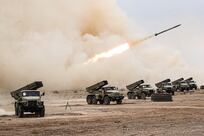This summer's market meltdown erased two US investment banks from the map, forced those remaining to overhaul their business models and left the world's largest insurer, AIG, in need of a last-ditch bailout. Oh, and the US government took over Fannie Mae and Freddie Mac, America's largest mortgage guarantors, arranged a fire sale of Washington Mutual, one of the largest banks in the US, and announced plans for a massive olive branch to Wall Street intended to cleanse the system of toxic debt.
That was scary stuff - and a lot of news for investors to absorb. As the carnage spread, few assets seemed safe, and those that did became expensive as the erstwhile risk-happy crowd flocked to US Treasury bills and cash. Stock markets got pummelled as a result. Indexes in the US last month declined to levels not seen in five years. Markets in the Gulf have suffered, too, dropping upwards of 50 per cent as jittery foreigners cashed out.
Now, as the summer of chaos morphs into what could easily be a winter of discontent, it may be a good time to look for gems among the rubble. Because let's face it: while companies across the board have seen their stock prices decline significantly, most of these enterprises clearly won't go the way of Lehman Brothers or Merrill Lynch. Moreover, an old maxim of investing says that you should be fearful when others are greedy, and greedy when others are fearful. If that's the case, now is definitely a time to be greedy. But greedy for what?
The argument Among emerging markets, Brazil and Russia look like the best bargains, analysts say. As part of the big four of the developing world - the others are India and China - they make a massive footprint on the world's economic stage. And stocks in these countries cheapened considerably during the summer turmoil. Russian companies lost roughly 78 per cent, while Brazilian firms got nipped for 60 per cent, putting both markets on sale for less than half price. Russia is the riskier of the two, the shaky political situation there being the main reason, but both offer good prospects as oil prices stabilise and global demand for Russian and Brazilian agricultural products soars.
Russia is the riskier of the two, the shaky political situation there being the main reason, but both offer good prospects as oil prices stabilise and global demand for Russian and Brazilian agricultural products soars. "Brazil is healthy," says Kurram Jafree, the head of investment management at Barclays Wealth in the Middle East. "Metals and mining make a large percentage of gross domestic product, so if you want to play on commodities prices, that's a good way. The market has been on a roller coaster, and if risk aversion falls, that's the kind of market within emerging markets that's going to rally." The way in A diversified emerging market fund with exposure to Russian and Brazilian assets accomplishes it in one swoop.
American Funds New World (NEWFX) is a solid choice, with an expense ratio below one per cent per year and returns that bested the MSCI emerging markets index by more than five per cent a year for the past five years. Its top holdings include the Russian fertiliser manufacturer Uralkali, the natural gas giant Gazprom and Brazilian Petroleum. If you would rather take a gamble with country-specific investing, look to exchange-traded funds, or ETFs, like iShares MSCI Brazil Index (EWZ) or Market Vectors Russia (RSX). ETFs are indexes that trade on an exchange like stocks, which makes them great options if you want a low-cost, passive way in. Expenses are low and you get a broad, diverse index of companies in each country. Keep in mind, though, that investing in these countries carries real risks, especially if you go with a concentrated fund like one of the ETFs above. According to a Citigroup estimate, foreigners took US$25 billion (Dh91.8bn) out of Russian stocks over the summer, and the country's simmering conflict with Georgia has not helped investor confidence. About 75 per cent of Russian stocks are in the oil and metals sectors, too, which makes oil's recent price declines all the scarier for investors.
According to a Citigroup estimate, foreigners have taken $25 billion out of Russian stocks over the summer, and the country's simmering conflict with Georgia hasn't helped investor confidence. About 75 per cent of Russian stocks are in the oil and metals sectors, too, which makes oil's recent price declines all the scarier for investors.
The argument Stock valuations across developed countries in the euro zone have declined to a point where some market watchers are beginning to see an upside. The FTSE 100, an index of large stocks listed in London, has declined roughly 29 per cent from a high of 6,376.50 in May. Broader European indexes have dipped even more, by about 32 per cent. In a strategy note on the region released in September, the investment bank Morgan Stanley said its "composite valuation indicator" - a mash-up of the most common ways of valuing stocks - reached its lowest point in its history, even below where it was after the recession of 1987 and at the end of the tech-stock bubble in 2000. "There is a good chance that the low point of this bear market has been reached," the report said. Separately, a survey of fund managers by the brokerage Merrill Lynch found that many believed euro zone stocks were the most undervalued in the world, even though they saw European stocks as having the least favourable outlook for corporate profits. That all points to the main risk of investing in Europe now: things could clearly get worse.
The way in In uncertain times like these, nothing but a diversified portfolio will do. Insurance companies, mining operations and energy firms in Europe look particularly cheap right now, but staking your investing future on these slices of the market, when the very nature of the market appears to be in flux, is probably not good advice. So go for diversified European mutual funds with managers used to finding value. BlackRock EuroFund (MDEFX) is one such fund. It comes with a reasonable 1.2 per cent expense ratio, although you will pay a 5.25 per cent load when you buy new shares. Mutual European (TEMIX) is another strong choice. It has racked up returns of almost 12 per cent annually over 10 years, and is ahead of its index this year by a whopping 13.3 percentage points.
The argument No region has taken more of a beating than North America, at least in the eyes of global investors seeking a scapegoat for the downturn. This makes sense, given that the subprime mortgage crisis that touched off the credit crunch, and eventually the financial meltdown, started there. That dent in America's financial armour has also meant that American stocks - or at least some of them - are trading at bargain basement prices. The legendary investor Warren Buffett has seized on the impressive cheapness of American companies, snapping up a sizeable portion of the investment bank Goldman Sachs for US$5 billion (Dh18.36bn) in September. Nevertheless, it is a dizzying time to think about investing anywhere in or near the US financial system. Projections almost universally paint a picture of steady declines across the economy for the next few quarters before a recovery begins. But if you have the guts and plenty of time to see your investment play out, analysts point to solid companies across the spectrum that have held up well despite the recent hammering. Most fund managers in Merrill Lynch's September survey were not so bullish about banks, insurance companies, and energy and utilities stocks. But they see plenty of upside for boring old consumer staples companies and tech stocks.
Nobody can be sure, however, when a recovery will happen (no, you can't time the market, unless your name is Marty, you drive a Delorean and you just got back from the future). If you have the guts -and plenty of time to see your investment play out - analysts point to solid companies across the spectrum that have held up well despite the recent hammering. Most fund managers in Merrill Lynch's September survey were not so bullish about banks, insurance companies and energy and utilities stocks. But they see plenty of upside for boring old consumer staples companies and tech stocks, which have endured a long stretch of slow growth.
The way in This is a time when money managers who search out value - people who look for cheap stocks - have an edge. Ideally, you should be buying mutual funds that passively track major indexes such as the S&P 500 or the Russell 3000 instead of taking bets on sectors. The biggest index fund in the universe is also one of the cheapest - the Vanguard 500 Index (VFINX) will run you a mere 0.15 per cent per year in expenses, and as is always the case with Vanguard's line-up, you will not pay a dime in sales costs. If you insist on active management, you have a plethora of value-orientated American mutual funds to choose from. Dodge & Cox Stock (DODGX) is a perennial favourite, as are Muhlenkamp (MUHLX) and Sound Shore (SSHFX).
The UAE markets, like other emerging markets, are still a risky bet. Volatility has surged amid the global economic crisis, and major indexes across the region have lost upwards of 30 per cent. Yet some analysts do sniff bargains at these levels, mainly in the property and construction sectors. The Abu Dhabi property developer Aldar, for example, is trading at less than three times next year's earnings, a ridiculously low price for what most analysts consider a well-run company - all seven analysts who cover the stock rate it a "buy". Arabtec, a large construction outfit, has also raised interest with its 77 per cent drop in share price and price-to-earnings multiple of 2.9. All 11 of the analysts who cover it rate it a "buy". In the UAE, as in America, Europe and just about everywhere else, markets are not going up. Yet you are not out of opportunities. It may be hard to muster up the courage to invest these days, and it's true that nobody knows exactly what the future holds. If you can overcome your understandable reluctance to be in the market, though, history is on your side. Investors at the bottom have long outclassed those who got in on the upswing or near the top. If you had bought Dh10,000 in US stocks in Dec 1987, for example, a couple of months after the October crash, you would have a kitty worth Dh31,576 today. If you had waited a year out of fear, you'd still have a lot - about Dh24,250 - but not as much as if you had the guts to go in when things looked bad.
afitch@thenational.ae





